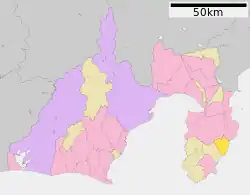Higashiizu
Higashiizu (東伊豆町, Higashiizu-chō) is a town located in Kamo District, Shizuoka Prefecture, Japan. As of 30 June 2019, the town had an estimated population of 12,155 in 6264 households,[1] and a population density of 160 persons per km². The total area of the town is 77.83 square kilometres (30.05 sq mi).
Higashiizu
東伊豆町 | |
|---|---|
 Hokkawa Onsen in Higashiizu | |
 Flag  Seal | |
 Location of Higashiizu in Shizuoka Prefecture | |
 Higashiizu | |
| Coordinates: 34°46′N 139°2′E | |
| Country | Japan |
| Region | Chūbu Tōkai |
| Prefecture | Shizuoka |
| District | Kamo |
| Area | |
| • Total | 77.83 km2 (30.05 sq mi) |
| Population (June 30, 2019) | |
| • Total | 12,155 |
| • Density | 160/km2 (400/sq mi) |
| Time zone | UTC+9 (Japan Standard Time) |
| Phone number | 0557-95-1100 |
| Address | 3354 Inatori, Higashiizu-chō, Kamo-gun, Shizuoka-ken 413-0411 |
| Climate | Cfa |
| Website | Official website |
| Symbols | |
| Flower | Isobuki |
| Tree | Sakura |
.jpg.webp)

Geography
Sandwiched to the east and west between the Amagi Mountains and Sagami Bay on the Pacific Ocean, Higashiizu has numerous hot springs. Warmed by the warm Kuroshio Current, the area enjoys a warm maritime climate with hot, humid summers and mild, cool winters. Parts of the town are within the borders of Fuji-Hakone-Izu National Park,

Demographics
Per Japanese census data,[2] the population of Higashiizu has been in slow decline over the past 40 years.
| Year | Pop. | ±% |
|---|---|---|
| 1940 | 10,118 | — |
| 1950 | 13,310 | +31.5% |
| 1960 | 15,246 | +14.5% |
| 1970 | 16,220 | +6.4% |
| 1980 | 17,030 | +5.0% |
| 1990 | 16,719 | −1.8% |
| 2000 | 15,807 | −5.5% |
| 2010 | 14,065 | −11.0% |
Climate
The city has a climate characterized by hot and humid summers, and relatively mild winters (Köppen climate classification Cfa). The average annual temperature in Higashiizu is 16.2 °C (61.2 °F). The average annual rainfall is 2,357.6 mm (92.82 in) with June as the wettest month. The temperatures are highest on average in August, at around 26.0 °C (78.8 °F), and lowest in January, at around 6.9 °C (44.4 °F).[3]
| Climate data for Inatori, Higashiizu (1991−2020 normals, extremes 1978−present) | |||||||||||||
|---|---|---|---|---|---|---|---|---|---|---|---|---|---|
| Month | Jan | Feb | Mar | Apr | May | Jun | Jul | Aug | Sep | Oct | Nov | Dec | Year |
| Record high °C (°F) | 20.5 (68.9) |
24.0 (75.2) |
25.7 (78.3) |
28.8 (83.8) |
31.1 (88.0) |
34.9 (94.8) |
35.6 (96.1) |
36.4 (97.5) |
34.8 (94.6) |
31.6 (88.9) |
25.5 (77.9) |
23.5 (74.3) |
36.4 (97.5) |
| Average high °C (°F) | 10.6 (51.1) |
11.2 (52.2) |
13.9 (57.0) |
18.2 (64.8) |
22.0 (71.6) |
24.4 (75.9) |
28.3 (82.9) |
29.7 (85.5) |
26.5 (79.7) |
21.8 (71.2) |
17.4 (63.3) |
13.0 (55.4) |
19.8 (67.6) |
| Daily mean °C (°F) | 6.9 (44.4) |
7.2 (45.0) |
10.0 (50.0) |
14.2 (57.6) |
18.1 (64.6) |
21.0 (69.8) |
24.8 (76.6) |
26.0 (78.8) |
23.2 (73.8) |
18.7 (65.7) |
14.1 (57.4) |
9.5 (49.1) |
16.1 (61.1) |
| Average low °C (°F) | 3.9 (39.0) |
4.0 (39.2) |
6.5 (43.7) |
10.7 (51.3) |
14.9 (58.8) |
18.4 (65.1) |
22.2 (72.0) |
23.4 (74.1) |
20.8 (69.4) |
16.2 (61.2) |
11.4 (52.5) |
6.5 (43.7) |
13.2 (55.8) |
| Record low °C (°F) | −2.8 (27.0) |
−4.1 (24.6) |
−0.9 (30.4) |
1.6 (34.9) |
7.2 (45.0) |
12.2 (54.0) |
14.7 (58.5) |
17.7 (63.9) |
13.3 (55.9) |
8.2 (46.8) |
2.8 (37.0) |
−1.6 (29.1) |
−4.1 (24.6) |
| Average precipitation mm (inches) | 87.1 (3.43) |
123.7 (4.87) |
208.1 (8.19) |
236.8 (9.32) |
222.9 (8.78) |
298.1 (11.74) |
281.8 (11.09) |
183.8 (7.24) |
249.8 (9.83) |
227.1 (8.94) |
153.8 (6.06) |
84.7 (3.33) |
2,357.6 (92.82) |
| Average precipitation days (≥ 1.0 mm) | 6.8 | 7.3 | 11.0 | 10.7 | 11.1 | 13.6 | 11.9 | 8.8 | 11.8 | 11.2 | 8.8 | 7.3 | 120.3 |
| Mean monthly sunshine hours | 189.4 | 180.5 | 182.9 | 194.0 | 192.1 | 130.1 | 165.8 | 218.8 | 167.9 | 161.1 | 167.1 | 189.5 | 2,139.1 |
| Source: Japan Meteorological Agency[4][3] | |||||||||||||
History
During the Edo period, all of Izu Province was tenryō territory under direct control of the Tokugawa shogunate, and the area now comprising Higashiizu Town consisted of 5 villages (Inatori, Naramoto, Shirata, Katase, and Ōkawa). With the establishment of the modern municipalities system in the early Meiji period in 1889, the area was reorganized into two villages (Inatori and Jōtō) with Kamo District. Inatori was elevated in status of that of a town in December 1920. The town of Higashiizu was founded on May 3, 1959 through the merger of the town of Inatori with the village of Jōtō.
Economy
The economy of Higashiizu is dominated by tourism centered on the hot spring resort industry, and by commercial fishing.
Education
Higashiizu has three public elementary schools and two public junior high schools operated by the town government, and one public high school operated by the Shizuoka Prefectural Board of Education.
Transportation
Railway
Highway
Local attractions
References
- Higashiizu Town official statistics (in Japanese)
- Higashiizu population statistics
- 気象庁 / 平年値(年・月ごとの値). JMA. Retrieved April 12, 2022.
- 観測史上1~10位の値(年間を通じての値). JMA. Retrieved April 12, 2022.
External links
- Higashiizu official website (Japanese)
 Media related to Higashiizu, Shizuoka at Wikimedia Commons
Media related to Higashiizu, Shizuoka at Wikimedia Commons Geographic data related to Higashiizu at OpenStreetMap
Geographic data related to Higashiizu at OpenStreetMap